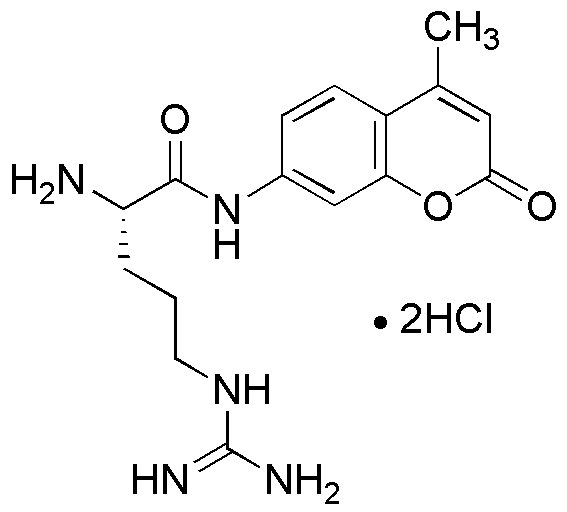L-Arginine 7-amido-4-methylcoumarin dihydrochloride is widely utilized in research focused on:
- Fluorescent Probes: This compound serves as a fluorescent probe in biochemical assays, allowing researchers to visualize and track cellular processes with high sensitivity.
- Enzyme Activity Measurement: It is used to assess the activity of various enzymes, particularly in studies related to nitric oxide synthase, which plays a critical role in cardiovascular health.
- Drug Development: The compound is explored in pharmaceutical research for developing new drugs targeting metabolic disorders, enhancing the understanding of arginine metabolism.
- Cellular Signaling Studies: It aids in the investigation of cellular signaling pathways, providing insights into how cells communicate and respond to their environment.
- Biochemical Research: The compound is valuable in studying protein interactions and modifications, contributing to advancements in molecular biology and biochemistry.
General Information
Properties
Safety and Regulations
Applications
L-Arginine 7-amido-4-methylcoumarin dihydrochloride is widely utilized in research focused on:
- Fluorescent Probes: This compound serves as a fluorescent probe in biochemical assays, allowing researchers to visualize and track cellular processes with high sensitivity.
- Enzyme Activity Measurement: It is used to assess the activity of various enzymes, particularly in studies related to nitric oxide synthase, which plays a critical role in cardiovascular health.
- Drug Development: The compound is explored in pharmaceutical research for developing new drugs targeting metabolic disorders, enhancing the understanding of arginine metabolism.
- Cellular Signaling Studies: It aids in the investigation of cellular signaling pathways, providing insights into how cells communicate and respond to their environment.
- Biochemical Research: The compound is valuable in studying protein interactions and modifications, contributing to advancements in molecular biology and biochemistry.
Documents
Safety Data Sheets (SDS)
The SDS provides comprehensive safety information on handling, storage, and disposal of the product.
Product Specification (PS)
The PS provides a comprehensive breakdown of the product’s properties, including chemical composition, physical state, purity, and storage requirements. It also details acceptable quality ranges and the product's intended applications.
Certificates of Analysis (COA)
Search for Certificates of Analysis (COA) by entering the products Lot Number. Lot and Batch Numbers can be found on a product’s label following the words ‘Lot’ or ‘Batch’.
*Catalog Number
*Lot Number
Certificates Of Origin (COO)
This COO confirms the country where the product was manufactured, and also details the materials and components used in it and whether it is derived from natural, synthetic, or other specific sources. This certificate may be required for customs, trade, and regulatory compliance.
*Catalog Number
*Lot Number
Safety Data Sheets (SDS)
The SDS provides comprehensive safety information on handling, storage, and disposal of the product.
DownloadProduct Specification (PS)
The PS provides a comprehensive breakdown of the product’s properties, including chemical composition, physical state, purity, and storage requirements. It also details acceptable quality ranges and the product's intended applications.
DownloadCertificates of Analysis (COA)
Search for Certificates of Analysis (COA) by entering the products Lot Number. Lot and Batch Numbers can be found on a product’s label following the words ‘Lot’ or ‘Batch’.
*Catalog Number
*Lot Number
Certificates Of Origin (COO)
This COO confirms the country where the product was manufactured, and also details the materials and components used in it and whether it is derived from natural, synthetic, or other specific sources. This certificate may be required for customs, trade, and regulatory compliance.


